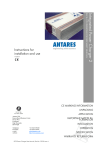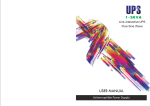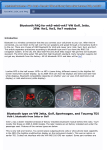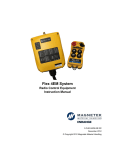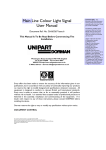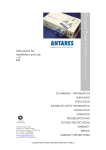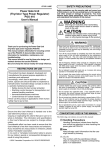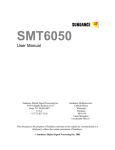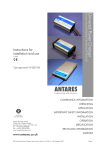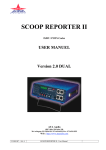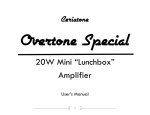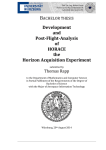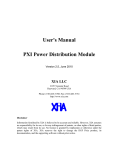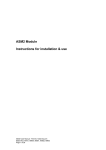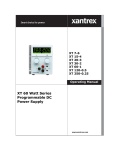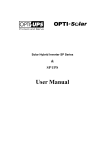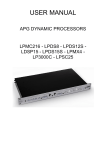Download Instructions for installation and use
Transcript
Integrated Power Charger 2 © 2004 24V & 12V VERSIONS FOR SPECIALIST VEHICLES Instructions for installation and use CE MARKING INFORMATION UNPACKING APPLICATION FM 37786 ISO 9001:2000 Antares (Europe) Limited Chiltern Hill . Chalfont St Peter Gerrards Cross . Bucks . SL9 9UQ . UK Tel: +44 (0)1753 890888 Fax: +44 (0)1753 891260 email: [email protected] web site http://www.antares.co.uk IPC2 Power Charger User Manual, Part No 13130 issue 3 IMPORTANT SAFETY INFORMATION INSTALLATION OPERATION SPECIFICATION WARRANTY RETURN FORM Page 1 CE MARKING - INFORMATION Conditions of use for which CE mark applies This equipment is intended to be used solely for professional purposes in commercial and light industrial locations, powered from the low-voltage public mains supply. Non approved conditions of use This unit may be suitable for use in other applications, but it can only be supplied as a component in this respect, for which the CE mark displayed on this manual does not apply. If the unit is used in this way, as a component part to build a battery charging or similar apparatus, then this unit is supplied solely on the condition that it is the responsibility of the manufacturer of the charging apparatus to ensure that the apparatus complies with the requirements of the relevant legislation, and apply the CE marking should it be required. In this case, this user manual does not apply, and reference should be made to Antares (Europe) Limited for any information required for compliance with the legislation. UNPACKING Pack contents: 1 Antares Power Charger 1 Instructions for Installation & Use APPLICATION The Power Charger is suitable for use under shelter only. It must not be exposed to rain. It is suitable for a wide range of applications on vehicles or in fixed locations, subject to the conditions of use stated above under CE marking. It may be used as a stand alone high performance DC power supply, or as a fully automatic multistage charger when connected to a battery. The charging characteristics of the standard model are optimised for flooded and retained electrolyte lead acid batteries. Please ensure that operation is confined to within the limits contained in the product specification given at the end of this manual. Suitable Battery Types: The power charger is suitable for charging the following types of battery: 12 VOLT MODELS: Flooded and retained electrolyte lead acid batteries of 12 volt rating, being made up from 6 cells connected in a series configuration. 24 VOLT MODELS: Flooded and retained electrolyte lead acid batteries of 24 volt rating, being made up from 12 cells connected in a series configuration. No attempt should be made to charge non-rechargeable batteries with this unit, as a hazard could result. IMPORTANT SAFETY INFORMATION 1 Please read and observe the installation instructions, which contain further safety information. IPC2 Power Charger User Manual, Part No 13130 issue 3 Page 2 2 WARNING: Explosive gasses may be generated by a battery on charge. To prevent ignition, allow time for gasses to disperse before attempting to connect this unit to the supply battery. 3 Statutory Notice: The wires in the mains input lead are coloured in accordance with the following code: Blue: Neutral Brown: Live Green/Yellow: Earth If the colours of the wires in the mains lead of this equipment do not correspond with the markings in your plug, proceed as follows: The Blue wire must be connected to the terminal marked N or coloured Black. The Brown wire must be connected to the terminal marked L or coloured Red. The Green/Yellow wire must be connected to the terminal marked E or coloured Green. THIS EQUIPMENT MUST BE EARTHED 4 Low Voltage Circuits This equipment must be installed in such a way that high currents present in any battery circuits or other output connections are prevented from flowing through the equipment mains lead. Such currents could damage the integrity of the protective earth connection. The incoming mains earth connects only to the Power Charger enclosure. Both the earth and enclosure are isolated from all Power Charger output circuits, which helps the above requirement to be achieved. The low output voltage from this unit does not present an electric shock hazard, but the high current available can be hazardous by virtue of its potential heating effect, particularly if batteries are also connected. The installation wiring must therefore be adequate for the currents involved, with suitable protection from potential fault conditions. Accidental bridging of high energy circuits by users (eg by jewellery) must be prevented. INSTALLATION Choosing a location Choose a location where the unit will not be subjected to water spray, dust, or insect ingress. Filters are available for the fan air intake, and must be fitted if a low dust environment cannot be provided. Locations subjected to high temperature or vibration must be avoided if performance and reliability are not to be impaired. The power system may be mounted in any orientation, but ensure that there is sufficient clearance at each end of the unit to allow air to enter and leave without undue restriction (15 to 20mm clearance is sufficient). Any possibility of the air vents becoming accidentally obstructed should be prevented. Ideally, the unit should be located in the same area as the load equipment or battery in order to minimise voltage drop in the DC output leads, and also to ensure that the Power Charger temperature compensating charge system samples air with the same temperature as the batteries. If a similar operating temperature environment cannot be provided, then a remote temperature sensor is available as an option. A range of extended output leads is available for situations where longer leads are required. Integral flanges are provided for ease of mounting in situations where the unit needs to be secured to prevent movement, such as in vehicles. Dimensional details and locations of the mounting holes are below. IPC2 Power Charger User Manual, Part No 13130 issue 3 Page 3 Mounting Integral flanges are provided for ease of mounting in situations where the unit needs to be secured to prevent movement, such as in vehicles. Ideally, the mounting should make electrical contact with the vehicle bodywork. Mounting hole locations are shown below. 100 100 50 205 9 50 9 130105-1 MOUNTING HOLES, DIAMETER 6.5mm OVERALL HEIGHT 98mm Connections AC input supply DC output ratings AC mains supply input Main output positive Main output negative 13.8 volt 1.5 amp auxiliary float output (if fitted) 130130-1 Mains Connection This equipment is designed for connection to public low-voltage single phase AC mains supplies. It is built to insulation class 1, and so must be earthed. The input voltage range for each model is given in the product specification at the end of this manual. The wires in the mains input lead are coloured in accordance with the following code: Blue: Neutral Brown: Live Green/Yellow: Earth The unit is equipped with a fuse in the input Live circuit only, located in the fuseholder inside the rear panel. Rupture of this fuse is indicative of a unit fault; it is not a user serviceable item. IPC2 Power Charger User Manual, Part No 13130 issue 3 Page 4 Earth leakage current is less than 1mA, which permits mains connection via an appropriate non-reversible mains plug if desired. If a standard UK domestic plug is used, it should be fitted with a 10 amp fuse. Local regulations, or regulations applicable to the intended application of this product, may override or impose additional requirements, which must be taken into account. Attention is drawn to the requirement for residual current circuit breakers in some vehicular applications. Output Connections WARNING: Explosive gasses may be generated by a battery on charge. To prevent ignition, allow time for gasses to disperse before attempting to connect this unit to the supply battery. The Power Charger is normally supplied with two flying leads for the main power output. The heavy gauge red lead is the connection to system positive, and the black lead to negative. Positive, negative or isolated chassis circuits may be connected. Be sure to disconnect the input supply before making or removing the connections to the battery. If the auxiliary 13.8 volt float output is fitted, it is accessible at the 6.3mm blade terminal at the AUX OUTPUT. Its negative is shared with the main output negative. In battery charging applications, both the positive and negative leads should ideally be routed directly to the battery terminals. This ensures that the Power Charger system responds only to the battery conditions, without being disturbed by other connected equipment. The unit is suitable for permanent connection to the battery. If a temporary connection is made to an automobile battery whilst in situ, proceed as follows: • • • • Ensure that the AC input supply is disconnected. Then connect the appropriate output conductor to the battery terminal which does not connect to the vehicle chassis (normally positive on negative earth vehicles), then connect the other output conductor to the battery terminal which connects to the vehicle chassis. Connect the AC input supply. To stop charging, disconnect the AC input supply then remove the battery connections in reverse order. The leads may be shortened if required. If longer leads are required, the leads supplied can be replaced or lengthened, using suitable cable, up to a maximum extended length of around 5 metres. Suitable cable sets can be supplied by Antares (Europe) Limited if required. Note that Power Charger units can be supplied to order with customer specified mains or output cable lengths and terminations. OPERATION The Power Charger system is fully automatic in operation. Three panel lamps show the operating condition of the unit: CHARGE: INPUT: PROTECTION: Green lamp - indicates that the battery is in the process of being fast charged. Green lamp - This lamp illuminates once fast charging is complete, indicating that the battery is being held on float. Red indicates that the unit has shut down due to an external fault or internal overheating. Recovery is automatic once the offending fault condition has been cleared. The Power Charger may be permanently connected to the battery, and continuously powered if required. There is no reverse drain on the battery when mains is disconnected and the unit is comprehensively protected from abuse or fault conditions. In vehicular applications, the engine may be started and run with the Power Charger system connected. IPC2 Power Charger User Manual, Part No 13130 issue 3 Page 5 SPECIFICATIONS Model range & part numbers 90165 - 12 volt 40 amp, 230VAC 90166 - 12 volt 40 amp, 110VAC 90167 - 24 volt 20 amp, 230VAC 90168 - 24 volt 20 amp, 110VAC 90173 - 24 volt 15 amp, 230VAC 90174 - 24 volt 15 amp, 110VAC 90175 - 24 volt 15 amp, with auxiliary 12V, 230VAC 90176 - 24 volt 15 amp, with auxiliary 12V, 110VAC 90177 - 24 volt 20 amp, with auxiliary 12V, 230VAC 90178 - 24 volt 20 amp, with auxiliary 12V, 110VAC 90181 - 12 volt 30 amp, 230VAC 90182 - 12 volt 30 amp, 110VAC Input specifications Input voltage range: 230 volt models: 200 to 264VAC continuous, 275VAC intermittent. 110 volt models: 95 to 121VAC continuous, 126VAC intermittent. Input frequency range: 45 to 66Hz Inrush current: 230 volt models: 85 amps peak, 1.2 milliseconds total inrush 0.1 amp-seconds 110 volt models: 39 amps peak, 5.2 milliseconds total inrush 0.2 amp-seconds Insulation class I; protective earth required, supplied via mains input cable. Output specifications Output voltage: 12 volt models: Float voltage Boost voltage Temperature coefficient 13.7VDC at 20° C 14.2VDC at 20° C -24mV/degC 24 volt models: Float voltage Boost voltage Temperature coefficient 27.4VDC at 20° C 28.6VDC at 20° C -47mV/degC Aux 12volt output: Float voltage Charging current 13.8VDC 1.5 amps (typical) Battery sensing threshold 12 volt models: 4.0 volts 24 volt models: 4.0 volts The battery voltage must be higher than this threshold for charging to commence. Climatic specifications: Operating temperature range: Full output power: Reduced output power (IPC2 is self limiting) IPC2 Power Charger User Manual, Part No 13130 issue 3 -5°C to +30°C +30° to +45°C Page 6 Antares (Europe) Limited Chiltern Hill Chalfont St Peter Gerrards Cross Buckinghamshire SL9 9UQ UK www.antares.co.uk Tel: +44 (0) 1753 890888 Fax: +44 (0) 1753 891260 q PRODUCT RETURNS FORM M q ADVANCE REPLACEMENT RETURNS FORM Date (TICK BOX ABOVE TO INDICATE TYPE OF RETURN) PLEASE USE THIS FORM TO ACCOMPANY RETURNS TO ANTARES (EUROPE) LIMITED. This will enable us to expedite your repair/return more efficiently. If you have your own return form, please attach it to this form. After receipt of your return we will either repair or replace the unit if within our warranty. If outside our warranty, we will provide a written quotation for repair/replacement. Please note that in the case of a ‘no fault found’ or the repair does not proceed, then a charge of £25 ex VAT and return carriage (if required) is payable. Goods arriving without suitable paperwork will take longer to process. Contact Company Name Delivery Address (for return) Part Number Serial Number Product Description Vehicle Type Registration/your reference Contact Fax Contact Tel Reason for return ( ( ( ( ( ( ( ) ) ) ) ) ) ) Advance replacement returned for credit against invoice ..… RA ……… Incorrect supply Please repair under warranty (Invoice date ……/……/……) Please quote for repair Please repair – purchase order attached ( ) Not required (note there may be a restocking charge) Unit for reconditioning (advance replacement RA# ………………) Description of observed fault and additional relevant information continued on separate page ( ) IPC2 Power Charger User Manual, Part No 13130 issue 3 Form 040 Issue 8 26.07.04 Page 7







